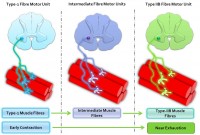The Difference Between Fast And Slow Twitch Muscle Fibres
When performing a strength training routine there are some things you should know about the different muscle fibre types. Since each muscle fibre type has various properties it is important to understand which ones you are using when you train. This allows you to make the most out of your workouts.
Muscle Fibre Type 1
The first muscle fibre type is called type 1. This is predominately the muscle fibre that is used when you perform endurance type of activities such as running or weight sessions where you are lifting in the 25 plus rep range. Generally if you are ever lifting in this fashion you are not looking to gain strength but rather hoping to improve the muscle fibre’s ability to deal with lactic acid build-up. This type of training should only be utilized by endurance athletes such as marathon runners or cyclists however as it is not really that beneficial for other athletes.
The type 1 muscle fibres are also very oxidative and contain a great deal of mitochondria. This helps them to utilize oxygen in an efficient manner and help to prevent fatigue from developing. They are generally smaller in size than the other types and have a slow contraction rate. Another common name for these muscle fibres is ‘slow twitch’.
Muscle Fibre Type 2a
The next muscle fibre type is called type 2a. These are much more focused on generating strength than the type 1 and have a rapid contraction rate. When you are performing typical strength training exercises in the 6-8 rep range this is predominately the muscle fibre type you are going to call upon. They have a high capability of generating ATP (high energy compound), which is the prime source of fuel for short duration activities.
These are larger in nature and still contain a fair amount of mitochondria but fatigue easier than the type 1 muscle fibres. Another name that these are sometimes referred to as is “fast twitch oxidative”.
Muscle Fibre Type 2b
The last muscle fibre type is called type 2b. These types of muscle fibres generate the most force and are used predominately in activities that require an all out burst of effort. They rely exclusively on ATP for fuel and are very large in nature. They have a small number of mitochondria and fatigue very rapidly.
These types of muscle fibres are going to be seen in highest proportions in athletes such as sprinters or power lifters. Since these athletes are rarely performing activities that last much longer than 60 seconds in length they simply do not need to develop their slow twitch muscle fibres.
While you cannot completely change one type of muscle fibre to another type, with training you can get them to behave more like a different type. This makes it important to adjust your strength training program so it is line with your goals and the type of activities you wish for it to compliment. The higher number of repetitions you perform the more you are targeting type 1 and the fewer number the more you are targeting type 2b with type 2a falling somewhere in the middle.
Related posts
13752 total views, 2 today






